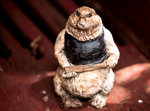




Anyone exploring the byways of the Key Peninsula has seen them, and maybe even been startled. Wooden bear cubs clinging to a tree, an enormous eagle perched atop a roof peak, a life-sized Sasquatch looming up at the end of a driveway.
Chainsaw woodcarvings are a Pacific Northwest tradition.
But there’s one hideaway on the KP where these creations come to life. Next to a stack of cedar trees stands a series of upright logs, roughly cut into vaguely familiar shapes. Further on, the shapes begin to resemble heads, wings or claws, or something more subtle. At the far edge, a giant owl roosts in silence, waiting for its feathers to be carved.
Dan Whited has been turning cedar into sculpture for 30 years. His owl might retail for $700 or $800. A life-sized Sasquatch would be closer to $2,000.
But it’s not a career he planned.
“I was working at Weyerhaeuser in their recreation department for two or three years, and they cut the whole thing,” he said. “As a going-away gift, they gave me career counseling. They said ‘you don’t really want to be a suit and tie at all. You want to be an artist.’ I knew artists and they’re all flakey and I didn’t want to be like that. They said, ‘that’s too bad, that’s where you’re going to be happiest.’ ”
Whited sought advice from a friend who ran a gallery in Tacoma. He suggested stone carving, since Whited seemed to have a good sense of three dimensional design.
“And as it turned out he was right,” Whited said. “I was able to picture something already done in a piece of material and just take everything off, and that’s the trick to being a good sculptor.” He had no formal training.
Whited spent a few years as a starving stone sculptor until he went to a symposium and met a chainsaw carver.
“He was having way more fun than me, so I switched over and a year or so later went to a contest and had so much fun I just couldn’t go back.”
The bulk of his time now is spent doing “production work.”
“Owls, eagles, bears, lots and lots of Sasquatches,” he said. “I sell through a place in Allyn, I’ve got another store down in Sandy, Oregon, and I’ve got one in Arkansas. They keep me pretty well busy.”
He has also done many commissions, including a life-sized mermaid fairy in Home — “a mermaid with a tail and fairy wings” — a seven-foot tall Pistol Pete — “the state mascot of Oklahoma” — and the infamous long-beaked plague doctor from Scotland that became popular during the pandemic.
“Covid was really good for me sales-wise. Everybody stayed home and needed to work in their yard and decided they wanted a carving for it,” he said.
“I used to do the Oregon State Fair every year, and did the Puyallup fair once and that was exhausting. I didn’t want to talk to people for about a month afterward. But I was able to buy a house with what I made there,” he said.
These days, Whited mostly sells wholesale. “I used to do more commissions when I was out carving at shows and whatnot, but it has to be interesting now before I’ll do it.”
One of his favorite pieces, done for his two children years ago, is a giant dragon skull.
“It came from ‘The Voyage of the Basset,’ ” he said. “It was a great story for kids and the illustrations were wonderful and at one point the character steals this prized dragon skull, and the chase is on. My kids thought that was the coolest thing ever, and I thought how hard could it be? I’ve done a number of them since. They don’t sell quickly, but they do eventually sell. When I got down to the last one, I said I’m going to keep it for myself. I don’t usually keep my own carvings around. Most of the carvings you see here were done by other people I admired.”
Whited works with western red cedar. He buys logs by the truckload, sets them up in his yard, and “blocks them down” with large saws into the rough shapes of whatever they will eventually become.
“I’ve carved all over the country and I’ve carved other woods, but this stuff has a tendency not to rot and it’s very predictable in its cracking and very forgiving so far as running the saw through it,” he said.
Whited uses electric tools as much as possible. “It’s quiet and I like my neighbors and don’t want to annoy them,” he said. “Once the piece is textured to the point where it doesn’t make sense to go any further, ‘that is the minimalist syntax that we sculptors employ to infuse the piece with a sense of anthropomorphic presence.’ That’s stolen directly from a sculptor magazine.”
Even after a full career, Whited doesn’t really think about retiring.
“For the most part, if I’m whittling with a big saw, I’m pretty happy. And every once in a while, I get to do something I really enjoy and that makes it even more worthwhile,” he said. “It’s paid the bills. I’m just going to keep getting slower and slower until I stop.”
UNDERWRITTEN BY THE FUND FOR NONPROFIT NEWS (NEWSMATCH) AT THE MIAMI FOUNDATION, THE ANGEL GUILD, ADVERTISERS, DONORS AND PEOPLE WHO SUPPORT INDEPENDENT, NONPROFIT LOCAL NEWS